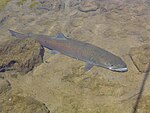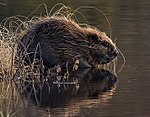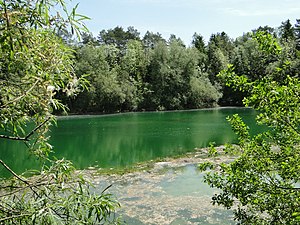Aitrach, Ach and Dürrenbach
|
FFH area "Aitrach, Ach and Dürrenbach"
|
||
|
Aitrach gravel pit |
||
| location | District of Ravensburg and District of Biberach , Baden-Württemberg , Germany | |
| Identifier | DE-8126-311 | |
| WDPA ID | 555623534 | |
| FFH area | 5.93 km² | |
| Geographical location | 47 ° 55 ' N , 10 ° 1' E | |
|
|
||
| Setup date | January 1, 2005 | |
| administration | Regional Council Tübingen | |
| particularities | 12 sub-areas | |
The FFH area Aitrach, Ach and Dürrenbach is located in the east of Baden-Württemberg and is part of the European Natura 2000 network of protected areas . It was designated in 2015 through the amalgamation of the existing FFH areas Aitrach and Herrgottsried as well as Ach and Dürrenbach by the Tübingen regional council. With the ordinance of the regional council of Tübingen on the definition of areas of community importance of November 5, 2018, the protected area was established.
location
The Aitrach, Ach and Dürrenbach protected area of around 593 hectares (ha) is located in the natural areas of Riß-Aitrach-Platten , Holzstocks and Unteres Illertal . Its 12 sub-areas are located in the communities of Tannheim in the Biberach district and Aichstetten , Aitrach , Bad Wurzach and Leutkirch in the Allgäu in the Ravensburg district.
description
The nature of the landscape of the protected area is essentially shaped by the rivers Aitrach , Lautracher Ach and Dürrenbach. The riparian forests that accompany the water are particularly characteristic. In addition, in addition to other small areas, the Herrgottsried near Bad Wurzach, the Laubener Brunnen and the Reichenhofer Hochwald also belong to the FFH area.
The waters in the area are also the habitat of bullheads and beavers .
history
The protected area was created by merging the original FFH areas 8026-341 “Aitrach and Herrgottsried” and 8126-341 “Ach and Dürrenbach”. These have existed since 2005.
Protection purpose
Habitat types
The following habitat types according to Annex I of the Habitats Directive occur in the area:
| EU code |
* | Habitat type (official name) | Short name |
|---|---|---|---|
| 3140 | Oligo- to mesotrophic calcareous waters with benthic vegetation of chandelier algae | Lime-rich, nutrient-poor still waters with chandelier algae | |
| 3150 | Natural eutrophic lakes with magnopotamion or hydrocharition vegetation | Natural nutrient-rich lakes | |
| 3160 | Dystrophic lakes and ponds | Natural dystrophic lakes | |
| 3260 | Rivers of the planar to montane level with vegetation of the Ranunculion fluitantis and the Callitricho-Batrachion | Running waters with flooding aquatic vegetation | |
| 6230 | * | Species-rich montane grass grass (and submontane on mainland Europe) on silicate soils | Species-rich bristle grass lawn * |
| 6410 | Pipe grass meadows on lime-rich soil, peaty and clayey-silty soils (Molinion caeruleae) | Pipe grass meadows | |
| 6430 | Moist tall herbaceous vegetation of the planar and montane to alpine level | Moist tall herbaceous vegetation | |
| 6510 | Lean lowland hay meadows (Alopecurus pratensis, Sanguisorba officinalis) | Lean, lowland hay meadows | |
| 7140 | Transitional and swinging lawn bogs | Transitional and swinging lawn bogs | |
| 7230 | Lime-rich fens | Lime-rich fens | |
| 8210 | Limestone cliffs with crevice vegetation | Limestone cliffs with crevice vegetation | |
| 9130 | Woodruff beech forest (Asperulo-Fagetum) | Woodruff beech forest | |
| 91E0 | * | Alluvial forests with Alnus glutinosa and Fraxinus excelsior (Alno-Padion, Alnion incanae, Salicion albae) | Alluvial forests with alder, ash, willow |
Species inventory
The following types of community interest exist in the area:
| image | EU code |
* | Art | scientific name | Species group |
|---|---|---|---|---|---|

|
1014 | Narrow diaper snail | Vertigo angustior | Snails | |

|
1105 | Huchen | Hucho hucho | Fish and round mouths | |

|
1163 | Bullhead | Cottus gobio | Fish and round mouths | |

|
1193 | Yellow-bellied toad | Bombina variegata | Amphibians | |

|
1337 | beaver | Castor fiber | Mammals | |

|
1902 | Yellow lady's slipper | Cypripedium calceolus | plants | |

|
1903 | Marsh glosswort | Liparis loeselii | plants |
Contiguous protected areas
The following nature reserves are part of the FFH area:
See also
Individual evidence
- ↑ a b c Tübingen regional council (ed.): Management plan for the FFH area 8126-311 Aitrach, Ach and Dürrenbach . by PAN GmbH. December 10, 2015 (143 pages, baden-wuerttemberg.de [PDF]).
Web links
- Standard data sheet for the FFH area "Aitrach, Ach and Dürrenbach"
- Profile of the FFH area Aitrach, Ach and Dürrenbach in the protected area directory of the LUBW
- Regional council Tübingen (ed.): Management plan for the FFH area 8126-311 Aitrach, Ach and Dürrenbach . by PAN GmbH. December 10, 2015 (143 pages, baden-wuerttemberg.de [PDF]).

